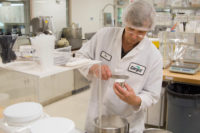Future Trends Explored at NPC
Prepared Foods October 18, 2004 enewsletter
Prepared Foods' 2004 New Products Conference explored a wealth of innovative and informational challenges for food developers, as well as trends impacting the industry today. In addition, executives from three of the industry's leading food manufacturers offered their insights into the major trends to watch over the coming decade. Following are their predictions for the top five trends on the horizon.
Todd Abraham, vice president of R&D with Kraft Foods (Glenview, Ill.):
- Convenience: particularly in an age where the number of hours worked per week is on the increase worldwide.
- Small-company impact: Industrial R&D is on the rise among smaller companies, which Abraham defined as those with less than 1,000 employees. Yet it is on the decline among companies with more than 25,000 employees.
- Globalization: Company consolidation continues -- among manufacturers, suppliers and even in the retail trade. In addition, Abraham cautions, knowledge knows no borders; e-work and video/teleconferencing have led to major food development on all continents.
- Changing demographics: By far the most definitive portion of Abraham's presentation, a population shift is occurring in America, on several fronts, in fact. The increased aging population is leading to such concerns as tiredness, stress, obesity, arthritis and eye health concerns. However, the aging shift is not unique to the U.S.: by 2020, Western Europe will see a 35% rise in the number of those over the age of 60, while numbers in Eastern Europe will increase 31%. These consumers are going to look for food to address the health issues affecting them. Also, the number of Hispanic households continues to rise and will soon result in Spanish becoming the most-popularly spoken language in the country. In addition, in a phenomenon seen around the world, the number of one- and two-person households is on the rise.
- Health/wellness: No longer solely an American concern, obesity is a worldwide problem. Furthermore, if Americans are eating more, it is not helping with their intake of certain essential elements. Two thirds of children and three quarters of adults fail to get enough calcium. Nine out of 10 adults and children do not get enough fiber in their diet. Some 9% of the U.S. has diabetes, with more than 177 million facing the disease worldwide. Lastly, but perhaps most importantly, the number-one killer in the U.S. is cardiovascular disease, which claims the lives of 60 million Americans per year.
- Boom-boom power: The U.S. has 78 million Baby Boomers; their children, the Echo Boom generation, number 73 million. Some 32 million of the resulting Boom-boom households have children under the age of 18. These Echo Boomers are particularly noteworthy: they have clout, with much discretionary income; accept and thrive upon diversity; value authenticity in brands, products and messaging; are savvy yet optimistic; and, in something somewhat unusual for a younger group, readily accept convergence -- meaning they have similar tastes between the Baby Boomers and their children.
- Authenticity: With such a large market appreciating authenticity, it makes obvious sense to include it as a major trend to watch. Consumers are beginning to favor authentic ingredients, methods, visuals, aromas, sources, brand images, etc. All of these serve to provide these consumers with a degree of reassurance in their foods.
- Confidence & safety: Fear of the safety of the food supply has resulted in an opportunity to deliver confidence through processing (preservation technology), endorsements (as seen in the Atkins branding at TGI Fridays [Carrollton, Texas] and Subway [Milford, Conn.]) and origin (the source of the food). This latter element has been the catalyst behind the 20% growth in organics and the resulting entry into that market by Coca-Cola (Atlanta), Kellogg (Battle Creek, Mich.), Kraft (Glenview, Ill.), General Mills (Minneapolis), H.J. Heinz (Pittsburgh), Dean (Dallas) and Unilever (New York), to name only a few.
- Healthy living: Similar to Abraham, Evans also regards obesity as an important trend for companies to address, especially considering 95% of consumers view it as a health problem. Companies are responding in a number of ways: choices, more information and portion control; yet these efforts will require promoting balance and getting Americans “on the move.”
- Sustainability: As Evans noted, the goal of sustainability is to meet present needs without compromising future generations. She described triple-bottom-line economics, which has to answer whether a company's decision is good for business, for people and for the planet. While not a widespread trend at present, sustainability efforts are underway in a number of companies, and these firms have lowered their usage of energy and water and dropped waste production, while increasing productivity and profits. Why have companies implemented such plans? 90% say it is to enhance their reputation; 75% say it gives them a competitive advantage, and 73% appreciate the cost savings from the moves.
- Customization: A large pocket of Americans have substantial discretionary income and are looking for items that “speak” to them. Willcocks advises that good design is not about creating the perfect thing, but about making something customizable, to make it something that individuals can tailor-make to be their perfect things, respectively. Examples of such efforts include the customizable bottle labels from Jones Soda (Seattle), printable M&Ms from Mars and the literally thousands of options available at such establishments at Starbucks (Seattle).
- Trading up: That discretionary income that Willcocks mentioned earlier also enters into play here, which entails an investment in products promising more but not priced out of reach. Premium ice creams and even high-quality ingredients, such as vinegar are just two such examples, as are super-premium grocery stores that have begun to appear in certain areas.
- Health: Healthier choices are becoming more the norm on fast-casual fast food, though at a slightly higher price. Meanwhile, ready-to-eat foods will continue to grow but with an increased emphasis on completeness versus convenience.
- Design: To make “boring stuff” look nice, Willcocks suggested developers keep three elements in mind when introducing a product. These three elements combine to comprise the consumer's regard for the product. They are: 1. visceral, the first impression, 2. behavioral (did the product work as promised/suggested?) and 3. reflective (would the consumer buy the product again?).
- Conscience: In a trend similar to the one proffered as “sustainability” by Evans, Willcocks believes future consumers are apt to appreciate values rather than value. Such conscience-minded decisions by companies will be a point of differentiation in the marketplace of the future. It allows businesses to become a positive source of change, change which will be to the advantage of future generations. While Willcocks believes such efforts as the move to organics are one element of this trend, he also believes companies' charitable contributions (be they to environmental, health-related or other causes) convey the message.
Looking for a reprint of this article?
From high-res PDFs to custom plaques, order your copy today!






